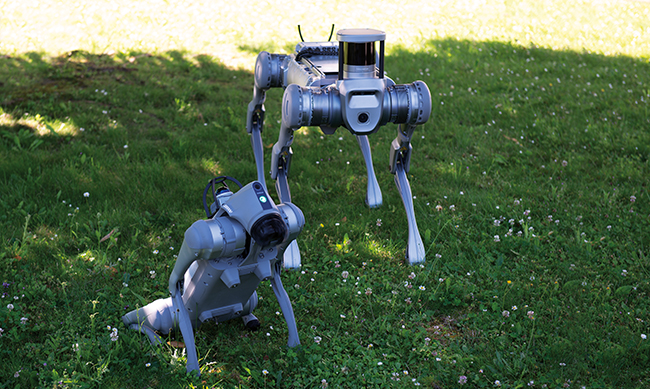It’s not just artificial intelligence (AI) that is making rapid progress. Robotics is also developing at an impressive pace. In this context, four-legged creatures are being developed that closely resemble dogs, but differ in many ways from their living counterparts – robot dogs. To keep pace with this exciting development, we have acquired two of these technological wonders: Floppy and Byte.

But why are we investing in robotics?
Investing in robotics is an investment in the future. We want to provide our customers with the best possible solutions and make their lives easier, their processes more efficient and their workflows more cost-effective.
And robotics has precisely this potential. From industrial automation to support in maintenance or data acquisition – robots can take over tasks that are too dangerous, too monotonous or too demanding for humans. At the same time, these robots are becoming cheaper and cheaper, which means that an investment is now quite economically possible for more companies.
What exactly can these robot dogs do?
Floppy and Byte are equipped with advanced sensors and AI that enable them to perceive and react to their surroundings. This enables Floppy and Byte to move around in different environments, avoid obstacles and plan routes. To do this, they still need a previous walk around to “get to know” the environment; however, our goal is for the robot dogs to be able to move completely autonomously in unknown environments and thus carry out ad-hoc missions. Climbing stairs is also no problem for the larger of the two four-legged friends.
What possible applications are there?
One particularly exciting use case, especially for the larger dog Byte, is perimeter surveillance. In security-critical areas, such as airports, industrial plants or large event locations, the robot dog can patrol the area or be sent out spontaneously if a sensor triggers an alarm. Cameras attached to the dog enable security personnel to evaluate the situation remotely, allowing them to not have to leave their post. This significantly increases location security and relieves the burden on human security staff.
Another important area of application is autonomous inspection. Floppy and Byte can be used to carry out regular inspections in hard-to-access or hazardous environments, such as offshore facilities, chemical plants or mines. They can detect damage, collect measured values and transmit them in real time to a central system, such as Framence’s photorealistic digital twin. This reduces the risk for technicians and ensures continuous monitoring of critical infrastructure.
Humanoid robots that are able to imitate human movements and tasks are also no longer science fiction – we will also be looking at these as soon as they become more ready for market use cases.
In order for you to benefit from our knowledge and the research we conduct in-house, our colleagues at Innomatik are dedicating the upcoming Afterhours to Floppy and Byte. So come and visit us in Bensheim, Hesse, on August 21 at 5 pm, talk to the experts on site about your use cases and get to know Floppy and Byte in person!